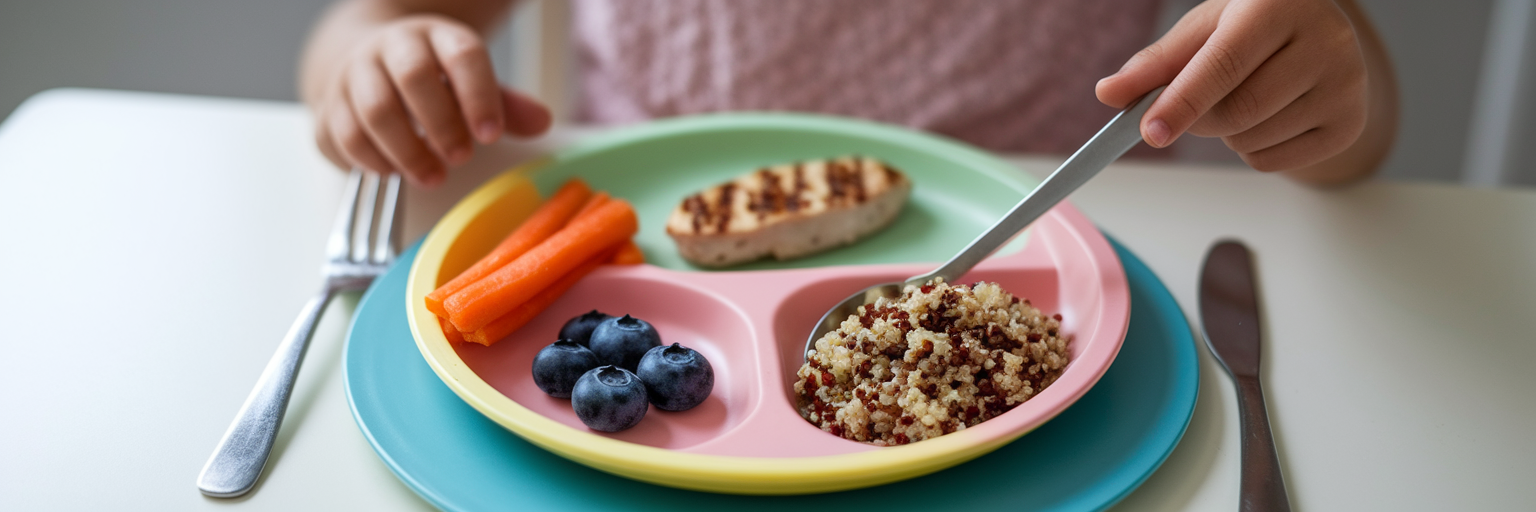It's a familiar scene in many American households: a carefully prepared meal met with a turned-up nose. You're not alone in this. Studies suggest that up to 50% of children between 1 and 2 years old are described as picky eaters by their parents, a phase that can sometimes extend well into childhood. While this can be a source of stress, understanding the 'why' behind food refusal is the first step toward encouraging your child to enjoy balanced meals picky eaters might actually embrace.
Understanding the Picky Eater Phenomenon
Picky eating is common and often a phase. Understanding its roots helps foster healthier eating habits supportively. When your child rejects foods, distinguishing typical development from persistent picky eating is key for less stressful mealtimes.
Defining Picky Eating vs. Normal Development
Many toddlers show food neophobia (fear of new foods), a normal stage they often outgrow. Persistent picky eating involves more intense refusal, like rejecting entire food groups. With patience, many children move past this.
Common Reasons for Food Refusal
Children might refuse food due to sensory sensitivities (texture, smell), a desire for independence, a past negative experience, or simply not being hungry. Identifying these helps guide your response.
The Parent's Role and Gentle Approaches
Pressuring kids to eat often backfires. Your role is to offer healthy choices in a calm, positive setting. This creates a low-stress environment for family meals picky eaters might enjoy. Be a guide, not an enforcer.
When to Seek Professional Advice
While often a phase, consult a professional for:
Significant weight loss or poor growth.
Signs of nutrient deficiencies (e.g., constant tiredness).
Extreme food refusal affecting social activities.
Regular choking, gagging, or swallowing issues.
Core Principles of Balanced Nutrition for Families
Understanding why a child might be selective, as we discussed, is one part of the equation. The other is knowing what balanced nutrition looks like for young, growing bodies. It’s not about gourmet meals, but rather a consistent offering of wholesome foods.
The Building Blocks: What Makes a Balanced Plate?
Imagine the USDA's MyPlate: half fruits and vegetables, the rest lean proteins and whole grains, plus dairy or an alternative. Fruits and vegetables offer vitamins, lean proteins (chicken, beans, tofu) build bodies, whole grains (oatmeal, brown rice) give energy, and dairy provides calcium. Together, they fuel growth and activity.
Key Nutrients for Growing Kids
Growing children especially need iron (from meats, beans, fortified cereals) for energy, calcium (dairy, leafy greens) for bones, fiber (fruits, veggies, whole grains) for digestion, and Vitamin D (fortified milk, sunlight). Focusing on sources of these helps provide healthy food for picky kids, even with a limited diet.
Adapting for Fussy Palates
If your child rejects many vegetables, focus on the few they accept or ensure other food groups temporarily compensate. Aim for variety over time, not perfection at every meal. The goal is a balanced intake across a week, not necessarily each day. This reduces pressure on everyone.
Understanding Kid-Sized Portions
Children need smaller portions than adults. Offer small, manageable amounts, like a tablespoon of each food for toddlers. This is less daunting and allows them to ask for more if hungry, reducing waste and respecting their appetite. It’s about quality, not just quantity on their plate.
This table offers a quick reference for essential food groups, their benefits, kid-friendly examples, and tips for encouraging picky eaters:
| Food Group | Primary Role | Examples for Kids | Tips for Picky Eaters |
|---|---|---|---|
| Fruits | Vitamins, Fiber, Antioxidants | Berries, apple slices, bananas, melon chunks | Offer in smoothies, as fruit 'fries' with yogurt dip |
| Vegetables | Vitamins, Minerals, Fiber | Carrot sticks, broccoli florets, sweet potato, peas | Serve raw with dip, blend into sauces, try 'fun' shapes |
| Whole Grains | Energy, Fiber, B Vitamins | Oatmeal, whole-wheat bread/pasta, brown rice, quinoa | Choose milder flavors, offer as toast, pancakes, or plain pasta |
| Lean Proteins | Growth, Repair, Iron | Chicken, fish, eggs, beans, lentils, tofu, lean ground meat | Offer in small, tender pieces; try meatballs, chicken strips, scrambled eggs |
| Dairy & Alternatives | Calcium, Vitamin D, Protein | Milk, yogurt, cheese, fortified soy/almond milk | Offer plain yogurt with fruit, cheese sticks, milk in smoothies |
Overall nutritional balance across several days is more realistic than perfection at each meal. Consistency and variety are key.
Practical Strategies for Introducing New Foods
Knowing what constitutes a balanced meal is important. But how do you get a hesitant child to try something new? It’s less about secret recipes and more about consistent, gentle strategies for picky eaters. Patience is your greatest ally.
The 'No Pressure' Tasting Rule
Embrace Ellyn Satter's Division of Responsibility: parents decide what, when, and where food is offered; children decide if and how much they eat. No bribing, no forcing. When pressure is off, children are more likely to explore. This is foundational for successful picky eater meal ideas.
The Power of Repeated, Neutral Exposure
It can take 10 to 20 or more exposures for a child to accept a new food. This is normal. Offer a tiny "tasting portion" alongside familiar foods without comment if uneaten. Consistent, patient exposure, as research often highlights, is more effective than pressure. Just keep offering, neutrally.
Food Chaining: Building on Accepted Foods
Food chaining links accepted foods to new ones with similar traits. If they like crispy fries, try baked sweet potato fries, then perhaps roasted sweet potato. This method bridges the gap from familiar to new by making small, incremental changes, making new foods feel less alien.
Involving Kids in Food Prep and Choices
Children involved in meal prep are often more interested in eating. It gives them ownership. Try these simple ways:
Let them wash vegetables or stir ingredients (with supervision).
Have them help set the table or pick a new fruit at the store.
If they help make something, like washing broccoli for a Broccoli and Cheddar Cheese Omelette, they might be more curious to taste it.
Making Food Fun and Visually Appealing
A little creativity helps. Use cookie cutters for sandwiches or fruit. Arrange veggies into a smiley face or give dishes playful names. You don’t need to be a food artist; small touches can make new foods less intimidating and more inviting to a cautious child.
Patience, persistence, and positive experiences are key, rather than seeking quick fixes.
Making Mealtimes Positive and Stress-Free
The strategies for introducing new foods work best when the mealtime atmosphere is positive. A calm environment can significantly influence a picky eater's willingness to try new things, making family meals picky eaters might even look forward to.
Consistent Mealtime Routines
Children thrive on predictability. Consistent meal and snack schedules help regulate appetite and reduce anxiety around food. Knowing when to expect meals makes them feel secure and more receptive to eating.
Minimizing Distractions for Mindful Eating
Screens and toys are major distractions. Turn off the TV, put away devices, and clear toys from the eating area. This helps children focus on their food, recognize hunger cues, and connect during meals.
The Impact of Positive Role Modeling
Children learn by observing. When they see parents and siblings enjoying varied, healthy foods and speaking positively about them, they're more likely to try them. Model the adventurous eating you hope to see.
Managing Expectations and Avoiding Battles
It's normal for children to refuse foods. Remain calm and neutral. Avoid power struggles, as these create negative food associations. Trust they'll eat from healthy options if hungry. This is one of the core strategies for picky eaters.
The 'Safe' Food Strategy
Always include at least one 'safe' food your child usually accepts. This ensures they won't go hungry if they refuse new items, reducing anxiety. For instance, with a new Thai Coconut Lentil Curry, also offer plain rice.
A relaxed, positive, and predictable mealtime is far more effective for encouraging adventurous eating than a stressful one.
Creative Meal Ideas Picky Eaters Might Try
With a positive mealtime foundation, a little creativity can help. These picky eater meal ideas focus on choice and presentation to make new foods less daunting.
Deconstructed Meals for Control
Serve meal components separately, like a taco bar. Letting children assemble their own plate gives control, making them more willing to try items.
Strategic 'Hidden' Ingredients (with Transparency)
Puree veggies into sauces or baked goods like Banana Bread with added carrot. Be transparent about ingredients over time to help them accept whole forms.
The Appeal of Dips and Sauces
Healthy dips like hummus or a Green Bean and Pea Yogurt Dip make veggies or protein strips appealing. Dips add fun and encourage exploration.
Breakfast for Any Meal
Whole-grain pancakes or eggs for lunch or dinner can be a comforting, accepted option, providing healthy food for picky kids when other choices are refused.
Smart Snacking for Nutrient Boosts
Nutrient-dense snacks are great, but time them carefully to avoid ruining appetites. For quick ideas using on-hand ingredients, an app like EasyChef might suggest Avocado Toast or other simple meals.
Creativity and involving children in choices can make a difference. Tools like EasyChef can also help by suggesting recipes from your ingredients, simplifying meal planning when you need fresh ideas.











